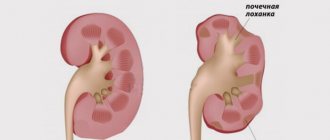HomeChildren's ClinicGynecologySynechia
Synechiae is the name given to congenital or acquired fusion of the labia minora, or less commonly, of the labia minora and labia majora. Most often, fusion occurs above the outlet of the urethra, thereby disrupting the normal outflow of urine. This condition causes discomfort to the child. Most often, synechiae occurs in children under 2-3 years of age.
Due to untreated synechiae, as the body grows, the external and internal genital organs may not form correctly, which may even result in impaired reproductive function.
Reasons for the development of pathology
The true cause of formations in girls has not been identified . There are many assumptions about the nature of this disease. Suggested factors in the development of synechiae:
Hormonal background
The arguments are confirmed by the fact that the frequency of synechiae increases sharply in girls from 1.5 to 6-8 years. In the first year of life, the baby receives female sex hormones - estrogens - from the mother in utero, and then through breast milk. And from 8-10 years of age, the ovaries begin to increase their own estrogen production. Consequently, the peak of the disease occurs precisely during the period with a minimum amount of estrogen.
Also confirming this theory is the fact that synechiae are very successfully treated with ointments containing estrogens - female sex hormones.
Inadequate genital hygiene
Synechiae can form both with insufficient hygiene and with its excess.
The use of any intimate hygiene products on a child is unacceptable. The soap used should not contain excess dyes and fragrances. A proven option is baby soap without additives (even if it says it contains sage or chamomile) or homemade soap.
Modern children often suffer from allergic reactions or, at a minimum, increased sensitivity to flavors, dyes and other substances. Just like excessive hygiene, this will lead to thinning of the skin in the genital area and the disappearance of beneficial microflora of the perineum. As a result, the skin becomes vulnerable, traumatic, and inflammation easily occurs. And the presence of an infectious process directly contributes to the formation of synechiae.
In contrast, lack of hygiene procedures leads to the entry of pathogenic flora into the vagina, for example, from the rectum. Inflammation occurs, and the delicate skin of the labia first sticks together, and then a delicate membrane is formed that connects them.
Any urinary tract infections
Urinary tract infections (UTIs) can cause synechiae to form. Together with urine, pathogenic microorganisms settle on the skin of the perineum and vulva, causing inflammatory changes there as well. Urethritis, cystitis, and pyelonephritis often lead to this.
UTI may develop as a result of the formation of synechiae, or changes in urine may be false due to the presence of vulvar adhesions. In the first case, the outflow of urine is disrupted due to the fact that the external opening of the urethra is covered by the labia minora welded together. In the second case, leukocytes will always be elevated in a general urine test, since they will enter it from the inflamed vulva.
Sexual infections
Despite the fact that the girl is not sexually active, she may be diagnosed with an STI - a sexually transmitted infection. This is explained by the fact that many STIs are also transmitted by contact - through washcloths, towels, underwear, etc.
The most common infections that can cause synechiae are gonorrhea , syphilis , and trichomoniasis . As a rule, infection occurs from the mother. That is why the mother should be examined by a gynecologist together with her daughter. STIs lead to the development of specific vulvitis (inflammation of the vulva only) and vulvovaginitis (inflammation of the vulva and vagina).
Other infections
Tuberculosis of the external genitalia stands out separately. It is rare. In 95% of cases it is combined with tuberculosis of other organs, most often the lungs. Tuberculosis is a contagious disease. Typically, synechiae of tuberculosis etiology occurs in families where there are also patients with this disease.
Allergic reactions
Allergies can manifest themselves both to hygiene products and to linen (especially colored and synthetic), powder and fabric softener, diapers, etc. When such increased sensitivity occurs, the baby develops constant itching and she scratches these areas. The result is secondary infection and the development of synechiae.
Complications of pregnancy and childbirth
A pattern has been revealed: in girls whose mothers suffered from preeclampsia during pregnancy (swelling, changes in urine analysis, increased blood pressure), synechiae occurs an order of magnitude more often with genital tract infections There is also an increased risk of adhesions in the vulva in children with congenital intrauterine infection and premature infants.
Injuries to the external genitalia
Improper hygiene measures and improper care of injured areas of the genital organs also lead to synechiae.
Parasitic diseases
Some parasites (pinworms, segments of pork and bovine tapeworms, Giardia) regularly enter the environment through the rectum, usually during sleep. This process is accompanied by severe itching in the perineum and rectum. Parasites also reach the vulva area. Children scratch these places, provoking the development of inflammation.
Chronic diseases
Some endocrine diseases can provoke the development of synechiae due to changes in the properties of the skin. More often it is diabetes mellitus (especially poorly compensated), hypothyroidism (lack of thyroid function).
In these situations, increased dryness of the skin and the appearance of microcracks are observed. And glucose metabolites in diabetes mellitus, being excreted through the skin, provoke the proliferation of pathogenic microflora, especially in places with active sebaceous and sweat glands.
Urethritis - diagnosis, treatment methods and all about how to avoid side complications.
Everything about the treatment of enterobiasis (parasites) in children is in this article >
Treat allergies promptly to avoid complications.
Why do synechiae occur?
Experts identify the following factors that provoke lip fusion:
- Violation of hygiene rules. Frequent washing with soap can damage the mucous membrane of the vulva and contribute to the formation of microcracks and wounds. Insufficient washing promotes the development of pathogenic organisms.
- Infectious diseases. A child can become infected with a sexually transmitted infection during childbirth, by using a shared washcloth or towel, or by swimming in a natural body of water.
- Allergic reaction. Allergies can affect not only the child’s skin, but also mucous membranes. In this case, food allergens most often cause fusion of the genital organs. The disease can develop as an allergic reaction to diapers, washing powder, soap and other products.
- Hormonal imbalances. The disease develops with a lack of the hormone estrogen.
- Pregnancy occurring with intrauterine infection.
- Wrong choice of underwear and diapers. When the genitals are rubbed, microcracks are formed, which promote fusion of the lips. Overheating of a child causes diaper rash, which negatively affects the genitals.
Symptoms of the disease
It is difficult to identify the initial stage of the disease at home on your own. The girl may not be bothered by anything. yellow or greenish are often detected on the laundry - a sign of inflammation.
With an allergic nature, the skin of the entire perineum will change - redness , rash , scratching , small blisters with light liquid. Mom may notice constant scratching of the genital area, buttocks and anus. Sometimes a child may complain of pain in the vulva area.
, the girl may experience painful urination . The child will try in every possible way to avoid going to the toilet again, and small children will be afraid of the potty. At the moment of urination, the girl may strain and strain, blushing at the same time.
Upon careful examination of the baby’s genitals, you can notice a thin whitish film that glues the labia minora partially, for example, by 1/3, or completely, while closing the entrance to the vagina and urethra. Sometimes the labia majora are also involved in the process.
Synechiae can occur between the labia majora and labia minora. Then, upon examination, it is clear that the skin of the small lip is “glued” to the large one. If the mother tries to separate the child’s labia, it causes pain, the girl is restless and may cry.
How do synechiae manifest?
With normal sexual development of a child, the posterior commissure of the vagina limits the entrance to its vestibule, while the labia minora have a thin layer of epithelium and are adjacent to each other. If the vulva is in order, then there is a clear demarcation of the labia minora from the labia majora and the genital fissure is visible, which allows an unobstructed examination of the vagina.
Dissection of synechiae of the labia minora is the removal of adhesions of the vulva or vestibule of the vagina, which are expressed in the fusion of the labia minora (sometimes fusion of the labia minora with the labia minora is observed).
With the development of disorders, fusion of the labia occurs, and in more complex cases, the union of the labia minora and majora occurs. Fusion can occur from the first days of a child’s life or during development. The first symptoms are a rash, redness and peeling in the intimate area.
The formation of adhesions causes difficulty urinating, and with the development of pathologies, urine flows into the vagina, which contributes to the development of inflammatory diseases.
Diagnostics
Parents may suspect the disease, but only an experienced obstetrician-gynecologist can definitively confirm it. A thorough visual examination helps make the diagnosis. How to identify the cause:
- Take a swab from the vestibule of the vagina from the girl.
- Take vaginal discharge (if any) for subsequent inoculation on a nutrient medium.
- Take general tests (blood, urine, glucose). A detailed examination is at the discretion of the doctor.
- Examination for parasitic diseases. The minimum complex is a scraping for enterobiasis (examination for pinworms). It is also recommended to test feces for Giardia cysts.
- Urine culture for pathogenic microflora.
Sometimes you have to resort to a more in-depth examination as recommended by your doctor.
Diagnosis of synechiae of the labia
Only a doctor can make a diagnosis of labia synechiae after a visual examination and a series of medical studies. Self-diagnosis and treatment of the disease can lead to a deterioration in the child’s condition.
To make an accurate diagnosis it is necessary:
- visual examination of the lips by a pediatric gynecologist;
- vulvoscopy (non-contact colposcopic examination of the external genitalia using an optical device);
- serological examination of smears and identification of bacterial causes of inflammation;
- tests for urogenital diseases (chlamydia, mycoplasmosis and others);
- blood and urine tests;
- checking blood sugar;
- checking for invasive diseases (detection of worms and dysbacteriosis);
- in the presence of congenital anomalies, an ultrasound examination of the pelvic organs is performed.
Disease prevention
Parents should try to reduce the risk of developing synechiae as much as possible:
- The child should, if possible, be breastfed for at least one year.
- All personal hygiene items - towel, linen, washcloths, soap, etc. – must be individual.
- You should wash yourself 1-2 times a day, plus after each act of defecation, using baby hygiene products without any additives.
- It is necessary to promptly identify and treat all infections, especially of the genitourinary tract.
- It is useful to strengthen the child’s immunity using both traditional medicine and modern pharmaceuticals.
- All allergenic foods and items should be avoided as much as possible. A girl's underwear should only be made from natural fabrics and light-colored. If possible, you should stop using diapers.
- Regular examination for parasites, prevention of these diseases 1-2 times a year (spring and autumn).
- If you have diabetes or problems with the thyroid gland, it is necessary to carefully monitor the child’s medication intake and monitor indicators.
- It is advisable not to use powders, all kinds of creams and perfume compositions in the genital area unnecessarily.
- Bath your child in plain water – without foaming agents or fragrances.
It is correct to wash your baby from front to back! For genital hygiene, there is no need to use washcloths and other devices - you need to do this with your hands.
Consequences
Synechiae that is not detected in time in a little girl can lead to improper formation of the baby’s genital organs, and then there is a possibility of problems with childbirth . A constant inflammatory process in the vulva area can lead to the spread of infection to the vagina, uterus and appendages. Difficulty urinating will provoke the development of diseases of the urinary system - cystitis, urethritis, pyelonephritis.
Treatment
If we imagine the treatment process as a sequence of actions as the process worsens or treatment becomes ineffective, it will look like this:
- Observation and correct hygiene measures.
- Using herbal decoctions in bathing water.
- Using regular creams.
- Use of hormonal ointments.
- Surgical separation of adhesions.
Therapy should be prescribed after examination by a pediatric gynecologist. Only he can decide whether the girl needs surgical treatment, or whether the disease can be dealt with without the use of a scalpel.
Conservative treatment takes place at home according to the strict recommendations of the doctor. Some obstetricians-gynecologists are convinced that one should always start with drug treatment, and if ineffective, resort to cutting adhesions. They motivate their position by the fact that the risk of relapse after surgical treatment reaches 80% .
Conservative treatment
It is most effective and is used in cases where synechiae covers a small area on the labia. The emphasis in conservative treatment is on compliance with all the rules of hygiene measures for the girl (see details in the “Prevention” section).
After taking water procedures, it is necessary to thoroughly dry the genitals and lubricate the labia with a rich baby cream containing lanolin.
Sea buckthorn oil and glycerin, peach oil and others are suitable. You can add a decoction of St. John's wort, chamomile, and calendula to the bathing water In such cases, prepare the infusion in advance and allow it to fully prepare for 8-10 hours, and then add it to the water when bathing.
Many gynecologists believe that nothing else needs to be done, and in such cases choose observational tactics in treating the baby. Creams and ointments containing female sex hormones are often used in treatment .
The most popular drugs are Ovestin , Colpotrophin . These drugs soften and loosen synechiae. Therapy with hormonal ointments usually continues for 2-3 weeks, with results assessed once every two weeks.
Scheme for using the cream and application rules
During the first two weeks, it is recommended to lubricate the synechiae twice a day after hygiene procedures.
Over the next two weeks, it is prescribed to lubricate the fusion site once with ointment, and a second time with lanolin-based baby cream.
After two weeks of such treatment, you should switch to using only the cream, with the aim of preventing relapse.
It is correct to apply the cream or ointment with your finger strictly along the line of the lip fusion, lightly pressing on this area, as if trying to separate it. However, such exposure should not bring the slightest concern to the child.
Some parents are wary of using estrogen-containing creams in young children, fearing systemic effects and the development of premature puberty. However, these prejudices are in vain. As a rule, the course of therapy is short and complications do not occur in most cases.
However, the use of ointments with estrogen should be supervised by an obstetrician-gynecologist , who regularly examines the baby’s mammary glands for engorgement, and also monitors hair growth in areas where hair growth is observed only from the moment of puberty - the armpits, pubis. The color of the skin in the armpits, inner thighs and genitals is also assessed.
If any systemic manifestations are detected, discontinuation of estrogen therapy leads to the return of the baby’s body condition to its previous state.
To avoid complications, it is recommended not to use hormonal treatment in girls less than one year old . For unexpressed synechiae, you can use contratubes instead of hormonal ointments. The cream has fibrinolytic, anti-inflammatory and absorbable effects. It is useful to use it in a mixture with another homeopathic cream - Traumeel S. The creams are mixed in equal proportions and applied using the same method as hormonal ointment.
In more complex situations, pediatric gynecologists recommend using creams in combination with estrogen-containing ointments. If your baby develops a rash, itching, or redness at the site where the cream was applied, you should consult a doctor - this may be an allergic reaction to the components of the drug.











